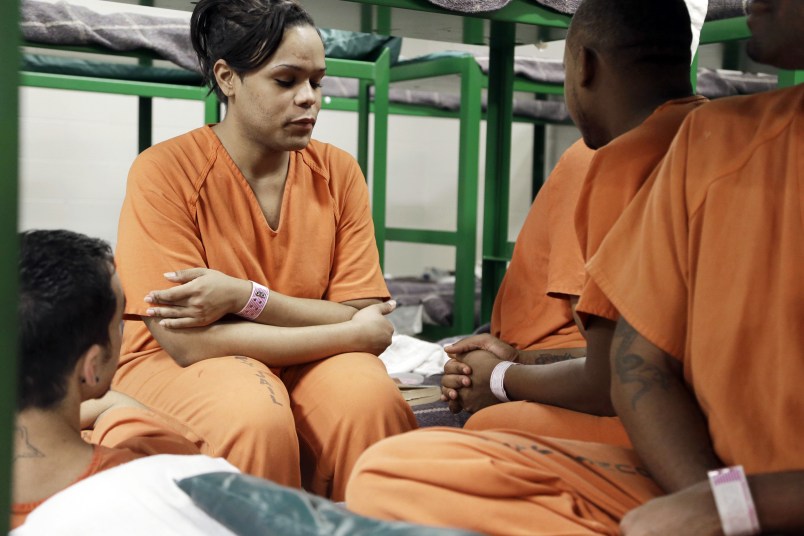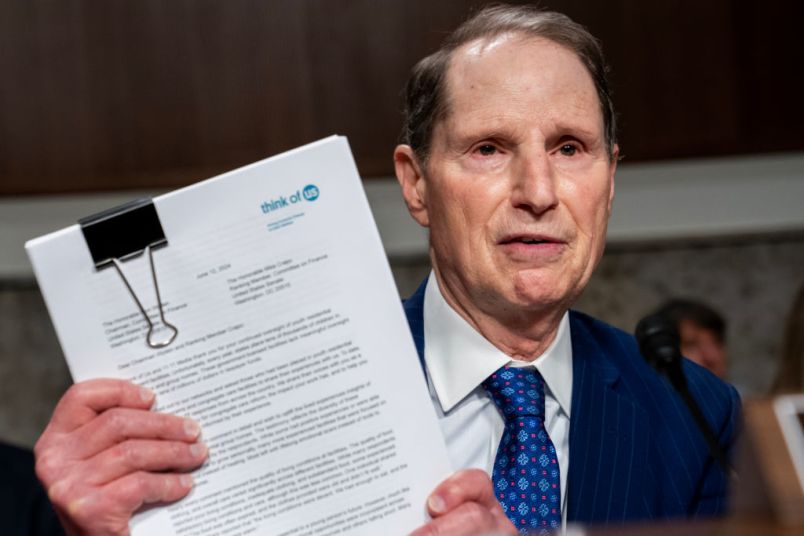HOUSTON (AP) — Black eyeliner rings Tyniesha Stephens’ large brown eyes. Her long, dark hair is pulled back in a ponytail, and she excitedly shares pictures of herself in the blonde wig and skirts she dons when she’s not in orange jail garb.
Yet Stephens lives among men in a Texas jail where she is serving a sentence for prostitution. And she knows she is nothing like them.
“I am feminine, a feminine person, a transgender woman, and some guys look at me, you know, with that eye,” Stephens, 28, said. “I feel very uncomfortable.”
Stephens, whose legal first name is Marques, has been taking hormones for 10 years and is partly transformed into a woman. She’s hopeful that soon, she can serve out her time in a women’s jail. But how soon — or if — that can happen is in question.
The Harris County Jail in Houston, the third-largest in the country which processes some 125,000 inmates annually, is one of many nationwide implementing changes to the way it treats its gay, lesbian, bisexual andtransgender population. The changes stem from a law passed by Congress under former President George W. Bush that requires federal, state and local lockups to eliminate rape in part by adjusting regulations about how the population lives behind bars.
It’s not easy. As jails sort out how to put the law into place, conflicts are arising between existing state laws and the federal rules, making the implementation process slow and difficult.
Housing is one of the most difficult questions. Until now, gays, lesbians and transgender inmates were often housed separately, but based on their biological gender. Stephens lives with gay men. The new rules say it is discriminatory, as well as potentially unsafe, to house people based on sexual orientation and gender, and so now they hope to house inmates based on where they will be safest, and consider gender identity when making that decision.
“Transgender women have to be eligible for women’s housing. That is where they will be safest,” said Harper Jean Tobin, director of policy for the Washington-based National Center for Transgender Equality. “These are women who are psychologically women.”
For someone like Stephens, even something seemingly as simple as whether she should be considered a man or a woman while in jail is complicated. The federal law, called the Prison Rape Elimination Act, says it should be up to the inmate. But Texas law requires a person to be housed according to their biological gender, said Brandon Wood, executive director of the Texas Commission on Jail Standards.
Commission officials testified before a Texas statehouse committee during the recent legislative session and explained the new federal rules, including the possible funding implications for prisons that could lose grant dollars if they fail to comply, Wood said. However, the Legislature chose not to tackle the law.
“Female inmates do not want someone who identifies as a woman, but isn’t, in their housing,” Wood said. “The potential for something very bad to go wrong does exist.”
Stephens has been in and out of jail 18 times on various prostitution and drug-related charges. She said she was once assaulted by another inmate. And there are some guards who call her derogatory names or insist on addressing her as Mister no matter how many times she tells them she is not a man, she says.
Statistics show why resolving the conflicts between state and federal law are necessary. Often, rape cases are difficult to prove, and few are prosecuted.
In a 2011 survey, the Department of Justice found a high rate of inmate-on-inmate sexual victimization in one of the Harris County Jail’s four buildings in downtown Houston. With a rate of more than 6 percent, it was nearly double the national average of 3.2 percent.
National studies also show that overall, more gay, lesbian, bisexual or transgender inmates report being raped than straight inmates.
Maj. Debra Schmidt, who oversees inmate classification, booking and release for the Harris County Sheriff’s Office, acknowledges that making the changes is difficult. A system that uses the type of crime, arrest record and gender to assign inmates has to be revamped. Staff needs to be retrained, and a culture among staff that may have allowed some to air their prejudices and go unpunished must change, she said.
“This is going to be a real challenge for law enforcement agencies,” Schmidt said.
Housing isn’t the only challenge. Jails also have to confront staffing levels to reduce rape, said Robert Goerlitz, president of the Harris County Deputies Organization, a group that represents more than 1,600 law enforcement officers, including jail guards.
“It’s awful dangerous for both sides of this thing, not only for the prisoners, but for the guards,” Goerlitz said, noting that each guard is responsible for monitoring 48 inmates. The new rules will not reduce rape if staffing is insufficient, he said.
The jail is also confronting things that are a part of everyday life behind bars, like strip searches. Houston’s new policy allows an inmate to choose the gender of the person who does a search, which conflicts with state law that requires inmates to be searched by someone of the same sex.
Recently, one transgender inmate, who — similar to Stephens — had only had a partial sex transformation was searched from the waist up by a woman and from the waist down by a man in order to comply with state law, said Lt. Walter Bailey, supervisor of inmate classification.
Some officers could be uncomfortable strip searching someone of the opposite sex, said Wood, with the Texasagency that oversees jails.
“I’ve created not one, but two issues,” he said.
For Stephens, the new policies are long overdue, and she is hopeful they lead to a better environment for inmates like her.
“There would be officers in there who had grudges against gay people and they would just come in here and tear up our stuff for no reason. They would come in and talk to us like we’re animals and handle us like we’re animals,” Stephens said. “It was unfair and unjust.”
__
Ramit Plushnick-Masti can be followed on Twitter at https://twitter.com/RamitMastiAP
Copyright 2014 The Associated Press. All rights reserved. This material may not be published, broadcast, rewritten or redistributed.









